Atlantic Weasel Shark
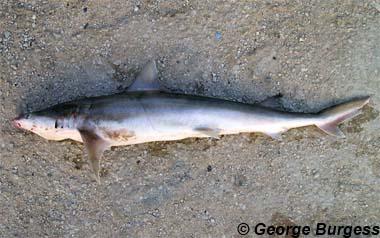
Paragaleus pectoralis
This small shark has a slender body, long snout, and large oval eyes. The fins are somewhat small except for the elongated, pointed pectoral fins, and it has an asymmetric caudal (tail) fin. This specialized feeder preys mostly on cephalopods like squid and octopus, but will sometimes eat small fish. Because of its size, usually no bigger than 4.5 feet long, and its specialized diet, it is considered little to no harm to humans.
Order – Carcharhiniformes
Family – Hemigaleidae
Genus – Paragaleus
Species – terraenovae
Common Names
The English language common name is the Atlantic weasel shark. Other common names include Atlantiese weselhaai (Afrikaans), Atlantische wezelhaai (Dutch), Atlantisk væselhaj (Danish), ehoushouinon (Fon GBE), marajo (Spanish), milandre jaune (French), requin (French), taess (Arabic), tiburón comadiza (Spanish), tiburón comadreja (Spanish) and tubarão-doninha (Portuguese).
Importance to Humans
Atlantic weasel sharks are caught on longlines, hook and line, bottom set gillnets, and bottom trawls. This shark is commercially important and is utilized fresh and dried salted for human consumption. It is also used in the processing of fishmeal.
Danger to Humans
There have been no documented attacks on humans by the Atlantic weasel sharks. Most weasel sharks are considered harmless to humans with the exception of the snaggletooth shark (Hemipristis elongatus) which is large enough to be considered potentially dangerous.
Conservation
> Check the status of the Atlantic weasel shark at the IUCN website.
The IUCN is a global union of states, governmental agencies, and non-governmental organizations in a partnership that assesses the conservation status of species.
Geographical Distribution
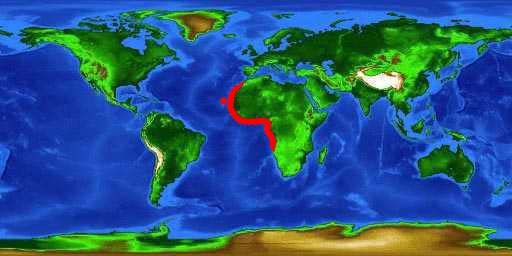
The Atlantic weasel shark is found in the tropical eastern Atlantic Ocean from Cape Verde and Mauritania to northern Namibia and possibly north to Morocco. There exists a record of this shark in the northwestern Atlantic Ocean off the coast of New England (US).
Habitat
Commonly found inshore to offshore of the continental shelf, the Atlantic weasel shark ranges from depths of a few feet (meters) down to more than 328 feet (100m).
Biology
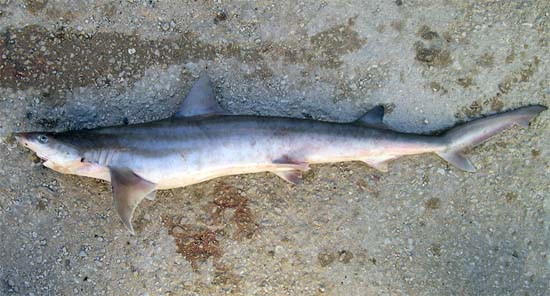
Distinctive Features
The Atlantic weasel shark has a slender body and moderately long snout. The broad oval eyes are large and possess internal nictitating eyelids. The mouth is rounded and moderately long. The first dorsal fin is located in front of the pelvic fins and is larger than the second dorsal fin. The second dorsal fin is approximately two thirds the size of the first dorsal and originates slightly anterior of the anal fin origin. There are no spines on either dorsal fin. The pectoral fins are elongate and pointed. The anal fin is smaller than the second dorsal fin. The pelvic and dorsal fins as well as the ventral caudal lobe is not falcate, a character used to distinguish this shark from other weasel sharks. The caudal peduncle is slender and lacks lateral ridges. This shark also has an asymmetric caudal fin with a strong ventral lobe as well as precaudal pits. The caudal fin terminates in a narrowly rounded tip.
Coloration
The dorsal surface of this weasel shark is light gray to bronze, with yellow stripes running down the length of the body while the ventral surface is white. The yellow stripes are not prominent in preserved specimens. The fins have no distinguishing marks.
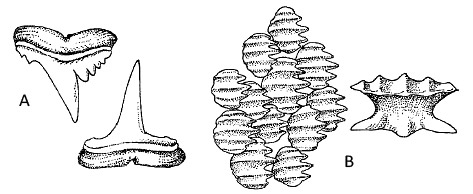
Dentition
The small mouth contains compressed teeth with distal cusplets and broad bases in the upper jaw and moderately long teeth with nearly straight smooth-edged cusps in the lower jaw. There are 26-30 rows of teeth in the upper jaw and 27-33 rows in the lower jaw with three of these rows located at the symphysis of the jaw.
Denticles
The dermal denticles of the Atlantic weasel shark are closely spaced and partially overlap. The blades are located on short pedicels and are nearly horizontal with five longitudinal ridges.
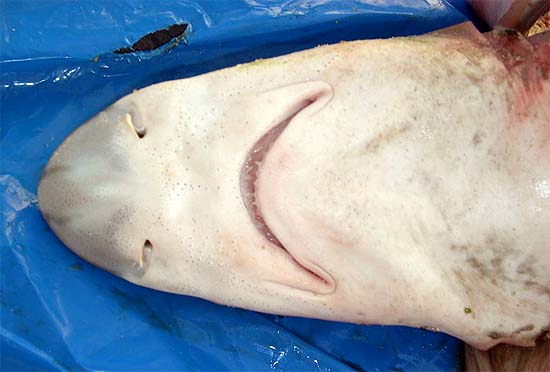
Size, Age, and Growth
The maximum total length of the Atlantic weasel shark is 54. 3 inches (138 cm). Sexual maturity is obtained at total lengths of 31.5 inches (80 cm) for males and 29.5-35.4 inches (75-90 cm) for females.
Food Habits
As a specialist feeder, the Atlantic weasel shark has a strong preference for cephalopods including squid and octopi. This shark will also feed on small bony fishes.
Reproduction
The Atlantic weasel shark is a viviparous shark giving birth to 1-4 young per litter. The young measure approximately 18.5 inches (47 cm) in length at birth. Off the coast of Senegal, most of the young are born during the months of May and June.
Predators
Potential predators of the Atlantic weasel shark are marine mammals and large fish including other sharks.
Parasites
Parasites of the Atlantic weasel shark include copepods as documented from a specimen captured off the coast of Senegal.
Taxonomy
Garman originally described the Atlantic weasel shark in 1906 as Hemigaleus pectoralis. This name was later changed to the currently valid name of Paragaleus pectoralis. The genus name, Paragaleus, is derived from the Greek “para” meaning the side of, and “galeos” meaning a kind of shark. Synonyms referring to this species in past scientific literature include Paragaleus gruveli (Budker 1935).
Prepared by: Cathleen Bester